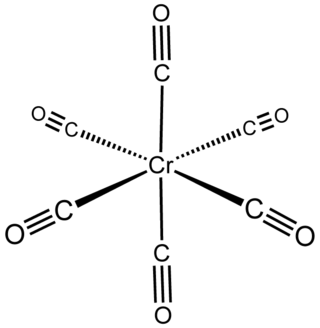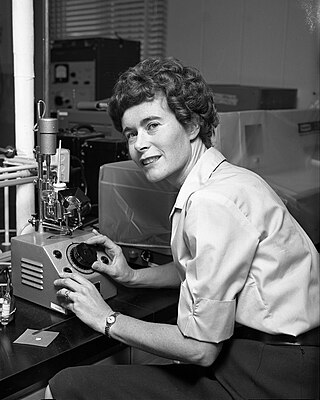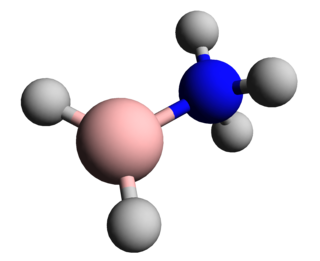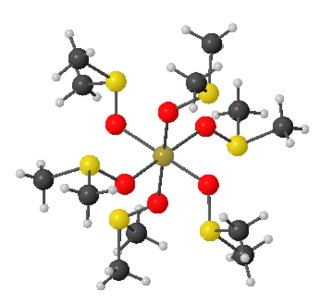
X-ray crystallography is the experimental science of determining the atomic and molecular structure of a crystal, in which the crystalline structure causes a beam of incident X-rays to diffract in specific directions. By measuring the angles and intensities of the X-ray diffraction, a crystallographer can produce a three-dimensional picture of the density of electrons within the crystal and the positions of the atoms, as well as their chemical bonds, crystallographic disorder, and other information.

Curcumin is a bright yellow chemical produced by plants of the Curcuma longa species. It is the principal curcuminoid of turmeric, a member of the ginger family, Zingiberaceae. It is sold as a herbal supplement, cosmetics ingredient, food flavoring, and food coloring.

A chemical structure of a molecule is a spatial arrangement of its atoms and their chemical bonds. Its determination includes a chemist's specifying the molecular geometry and, when feasible and necessary, the electronic structure of the target molecule or other solid. Molecular geometry refers to the spatial arrangement of atoms in a molecule and the chemical bonds that hold the atoms together and can be represented using structural formulae and by molecular models; complete electronic structure descriptions include specifying the occupation of a molecule's molecular orbitals. Structure determination can be applied to a range of targets from very simple molecules to very complex ones.

Chromium hexacarbonyl is a chromium(0) organometallic compound with the formula Cr(CO)6. It is a homoleptic complex, which means that all the ligands are identical. It is a colorless crystalline air-stable solid, with a high vapor pressure.

Kenneth Norman Raymond is a bioinorganic and coordination chemist. He is Chancellor's Professor of Chemistry at the University of California, Berkeley, Professor of the Graduate School, the Director of the Seaborg Center in the Chemical Sciences Division at Lawrence Berkeley National Laboratory, and the President and Chairman of Lumiphore.

Marjorie Constance Caserio was an English chemist. In 1975, she was awarded the Garvan Medal by the American Chemical Society.

In chemistry, a boranylium ion is an inorganic cation with the chemical formula BR+
2, where R represents a non-specific substituent. Being electron-deficient, boranylium ions form adducts with Lewis bases. Boranylium ions have historical names that depend on the number of coordinated ligands:

Judith P. Klinman is an American chemist, biochemist, and molecular biologist known for her work on enzyme catalysis. She became the first female professor in the physical sciences at the University of California, Berkeley in 1978, where she is now Professor of the Graduate School and Chancellor's Professor. In 2012, she was awarded the National Medal of Science by President Barack Obama. She is a member of the National Academy of Sciences, American Academy of Arts and Sciences, American Association for the Advancement of Science, and the American Philosophical Society.

Jenny Pickworth Glusker is a British biochemist and crystallographer. Since 1956 she has worked at the Fox Chase Cancer Center, a National Cancer Research Institute in the United States. She was also an adjunct professor of biochemistry and biophysics at the University of Pennsylvania.
Molecular Operating Environment (MOE) is a drug discovery software platform that integrates visualization, modeling and simulations, as well as methodology development, in one package. MOE scientific applications are used by biologists, medicinal chemists and computational chemists in pharmaceutical, biotechnology and academic research. MOE runs on Windows, Linux, Unix, and macOS. Main application areas in MOE include structure-based design, fragment-based design, ligand-based design, pharmacophore discovery, medicinal chemistry applications, biologics applications, structural biology and bioinformatics, protein and antibody modeling, molecular modeling and simulations, virtual screening, cheminformatics & QSAR. The Scientific Vector Language (SVL) is the built-in command, scripting and application development language of MOE.
In chemistry, compounds of palladium(III) feature the noble metal palladium in the unusual +3 oxidation state (in most of its compounds, palladium has the oxidation state II). Compounds of Pd(III) occur in mononuclear and dinuclear forms. Palladium(III) is most often invoked, not observed in mechanistic organometallic chemistry.
Lawrence Que Jr. is a chemist who specializes in bioinorganic chemistry and is a Regents Professor at the University of Minnesota, Twin Cities. He received the 2017 American Chemical Society (ACS) Award in Inorganic Chemistry for his contributions to the field., and the 2008 ACS Alfred Bader Award in Bioinorganic Chemistry.
Catherine (Cathy) Drennan is an American biochemist and crystallographer. She is the John and Dorothy Wilson Professor of Biochemistry professor at the Massachusetts Institute of Technology and a professor at the Howard Hughes Medical Institute.
Krystle McLaughlin is a Caribbean-American structural biophysicist. She is an assistant professor of chemistry at Vassar College.
Jenny Yue-fon Yang is an American chemist. She is a professor of chemistry at the University of California, Irvine, where she leads a research group focused on inorganic chemistry, catalysis, and solar fuels.
Sherine O. Obare is the dean of the Joint School of Nanoscience and Nanoengineering at the University of North Carolina at Greensboro and North Carolina Agricultural and Technical State University. She works on nanomaterials for sensing and drug delivery.
Connie C. Lu is a Taiwanese-American inorganic chemist and a professor of chemistry at the University of Bonn. She was previously a professor of chemistry at the University of Minnesota, Twin Cities. Lu's research focuses on the synthesis of novel bimetallic coordination complexes, as well as metal-organic frameworks. These molecules and materials are investigated for the catalytic conversion of small molecules like as N2 and CO2 into value-added chemicals like ammonia and methanol. Lu is the recipient of multiple awards for her research, including the National Science Foundation CAREER Award and the Sloan Research Fellowship in 2013, and an Early Career Award from the University of Minnesota's Initiative for Renewable Energy and the Environment in 2010.
Suzanne Cathleen Bart an American chemist who is a professor of inorganic chemistry at Purdue University. Her group's research focuses on actinide organometallic chemistry, and especially the characterization of low-valent organouranium complexes, actinide complexes with redox-active ligands, and discovery of new reactions that utilize these compounds. Bart's research has applications in the development of carbon-neutral fuel sources and the remediation of polluted sites.

Organoberyllium chemistry involves the synthesis and properties of organometallic compounds featuring the group 2 alkaline earth metal beryllium (Be). The area remains less developed relative to the chemistry of other main-group elements, because Be compounds are toxic and few applications have been found.

A transition metal sulfoxide complex is a coordination complex containing one or more sulfoxide ligands. The inventory is large.












